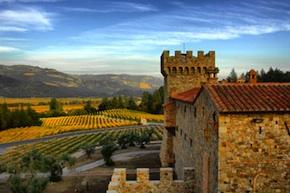Since the birth of contemporary music festivals — probably with the Newport Jazz Festival, in 1954 — hundreds of them have sprung up around the world. Chances are the Tuscan Sun Festival and its Festival del Sole twin in Napa offer the greatest mix of music, dance, landscapes graced by castles and vineyards, visual arts, food, and wine ... and more wine.
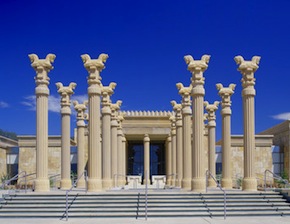
Festival founders Barrett Wissman and Nina Kotova started it all in 2003 in the Italian medieval town of Cortona with the idea of “friends making music together in a warm and welcoming atmosphere.” That atmosphere also happens to be historical, and spectacularly beautiful.
The same ideas and adjectives describe Festival del Sole in the beguiling Napa Valley, started in 2006 by local attorney Richard Walker, in cooperation with Wissman and Kotova. (Singapore’s Sun Festival was added in 2007.)
As in Tuscany, combining music with various art forms, against the background of a gorgeous landscape and bountiful food and wine, has been Walker’s guiding principle from the beginning. His philosophy: “We have one chance to live this life right. Make it count.”
So, from a luxurious opening event at the Darioush Winery last week to the closing night dinner on July 24 in Cardinale, the sixth festival offers a dizzying variety and choices.
In Darioush, with its grand entrance modeled after Persepolis, Russian and Spanish classical works will mix it up with Persian and Armenian music: Glinka, Rodrigo, Falla, Rachmaninov, Tara Kamangar, and Loris Tjeknavorian.
July 19 offers both luxurious and pricey culinary events, such as the Vintner’s Luncheon at Black Coyote Wines and gourmet dinner and concert for Pride Mountain Vineyards’ 20th anniversary — but also free concerts, including:
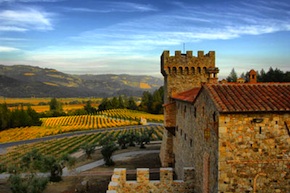
Oliver Poole’s recital in the Bouchaine Young Artist Concert Series, and something special — U.S. Army and Russian National Orchestra brass quintets join in a program of classical and jazz music, along with Russian and American popular songs from the World War II era.
There are two more free Bouchaine recitals in Jarvis Conservatory:
- Cellist Will Chow, 17 years old, 11 a.m., July 20
- Guitarist Mathew Lyons, 19, 11 a.m., July 22
In one of the area’s most dramatic settings, the medieval Castello di Amorosa, Sarah Chang and Kotova are featured Wednesday in music by Bernstein — a new arrangement of the West Side Story Suite — and Boccherini. The Russian National Orchestra is also performing Beethoven’s Symphony No. 4, under the baton of Omer Wellber, making his U.S. debut.
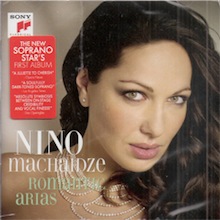
Chang and Kotova return on July 21 to the castle for an evening of chamber music, along with pianist Joyce Yang and soprano Nino Machaidze.
On the program: arias by Bellini, Donizetti, Puccini, Verdi, Massenet, and Rossini (with Hadley McCarroll as accompanist), and Brahms’ Piano Quartet No. 3 in C Minor, Op. 60, “Werther.”
Sponsored by Fine Arts Museums of San Francisco Board Chair (and part-time Napa Valley resident) Dede Wilsey, first-class ballet is featured at the festival for the second year, on July 22, in Yountville’s Lincoln Theater.
Featured dancers include Maxim Beloserkovsky and Irina Dvorovenko of American Ballet Theatre; Charles Askegard and Wendy Whelan of New York City Ballet; Vitor Luiz and Lorena Feijoo of San Francisco Ballet; and Marianna Ryzhkina, Denis Medvedev and Mikhail Kryuchkov of Bolshoi Ballet.
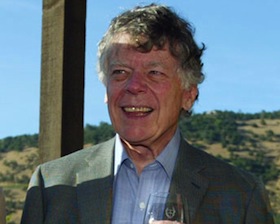
“This year Napa Valley Festival del Sole’s dance gala offers audiences a chance to revisit classic works from the ballet repertoire, in scenes from Petipa’s Swan Lake or Balanchine’s Jewels,” says Walker.
The program also features a number of newer works which demonstrate the vitality and dynamism of ballet. Among them are Yuri Possokhov’s Talk to Her, to Alberto Iglesias’ score for Pedro Almodóvar’s 2002 film, and Vladimir Vasiliev’s The Oath of Ushers, set to a movement of Gordon Getty’s Ancestor Suite, which debuted to great acclaim at the Bolshoi Theater in 2009.
There will be excerpts from the Balanchine/Stravinsky Agon, Bournonville’s La Sylphide, René Aubry’s Black with choreography by Francesco Ventriglia, and that great Petipa showpiece, the pas de deux from Le Corsaire.

